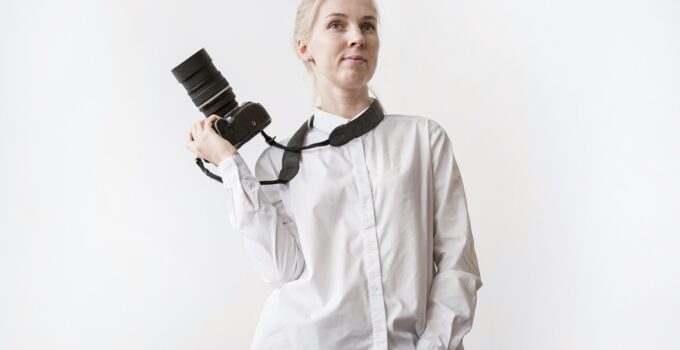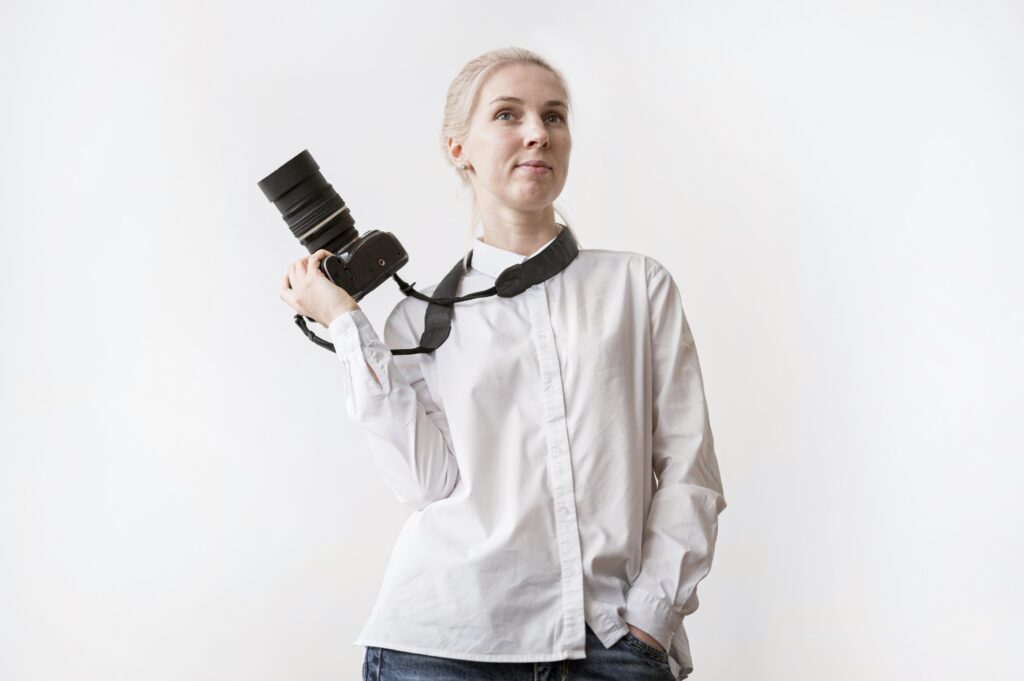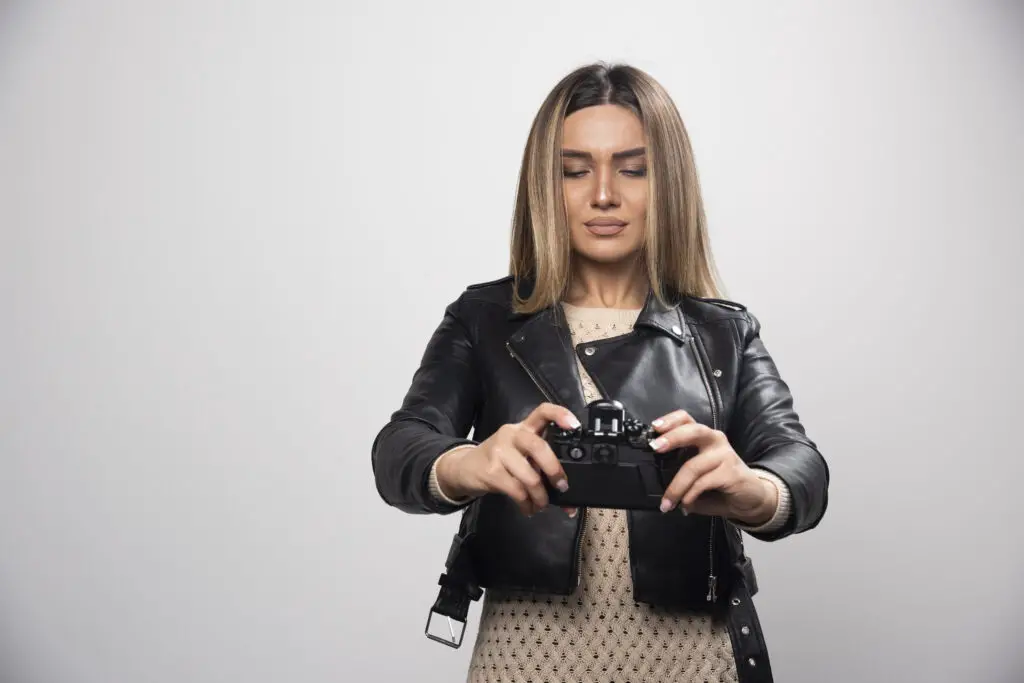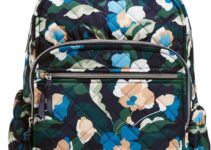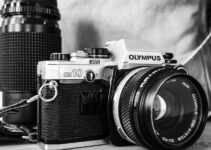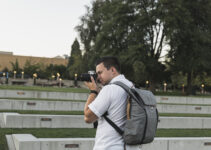Do professional photographers use camera straps? Absolutely. Camera straps are more than just accessories; they are essential tools for photographers who often work in dynamic environments.
While some may prefer to handhold their cameras for quick shots, the majority rely on straps for comfort, security, and convenience.
Whether capturing a wedding, wildlife, or street scenes, having a sturdy, reliable strap helps prevent accidental drops and keeps the camera accessible at all times.
Professional photographers often invest in high-quality, ergonomically designed straps that can be customized to fit their shooting style and needs, ensuring both safety and efficiency during shoots
Here how to make a bean bag for camera support?
Do professional photographers use camera straps?
Yes, professional photographers often use camera straps, but their preferences can vary depending on their style of photography and personal comfort.
Straps provide essential security by preventing accidental drops, especially during dynamic shoots like weddings, sports, or wildlife photography. They also help distribute the weight of heavy camera gear, reducing strain during long sessions.
Many professionals opt for high-quality, adjustable straps that allow quick access to their camera, enabling them to capture moments rapidly.
Some prefer using specialized straps like sling straps, which offer more flexibility and ease of movement, or harness systems that distribute weight evenly across the shoulders.
However, some professionals might forgo traditional straps in favor of hand grips, holsters, or belt systems, particularly if they need quick mobility or work in environments where a strap might get in the way.
Ultimately, the choice depends on the photographer’s needs, style, and comfort.
Do pro photographers use camera straps?
Should I use a strap for my camera?
Using a strap for your camera is generally a good idea, as it offers several practical benefits.
A camera strap helps prevent accidental drops, which is crucial for protecting your equipment, especially when you’re on the move or in busy environments. It also allows you to keep your hands free when not actively shooting, making it easier to manage other tasks or adjust settings.
Straps come in various styles, such as neck straps, sling straps, and wrist straps, so you can choose one that best suits your comfort and shooting style.
For long sessions or when carrying heavy gear, a strap can help distribute the weight and reduce strain on your neck, shoulders, or wrist.
However, if you find a strap restrictive or if it interferes with your shooting, you might consider alternatives like hand grips or holster systems. Ultimately, the choice depends on your personal preferences and the type of photography you do.
What is an alternative to a camera strap?
How do photographers hold their camera?
Photographers hold their cameras in a way that maximizes stability and control, ensuring sharp images and reducing the risk of camera shake.
Typically, the right hand grips the camera body, with the index finger resting on the shutter button. The left hand supports the lens or the bottom of the camera, providing additional stability.
For extra steadiness, photographers often tuck their elbows close to their body, creating a tripod-like support.
When shooting in portrait orientation, some photographers rotate the camera so that the shutter button is at the top, while others prefer it at the bottom, depending on comfort.
Here, what does a camera and money bag emoji means on tinder?
When shooting from a lower angle, photographers may rest the camera on their knee or ground, using their body as a support.
Some photographers also use the camera’s strap to add tension by pulling it tight against their neck or shoulder, further reducing movement. This careful handling helps maintain image sharpness and precision.
5 Reasons why do photographer use camera strap
7 Types of camera strap that pros use
Do professional photographers use camera straps?
Yes, professional photographers often use camera straps for their practicality and convenience. Straps provide essential security, helping to prevent accidental drops and protecting expensive gear during active shooting.
They also offer hands-free access, allowing photographers to keep their cameras readily available while managing other tasks or adjusting settings.
The choice of strap varies by preference and shooting style. Some pros use traditional neck straps for easy access and comfort, while others prefer sling straps for quick maneuverability and reduced neck strain.
Wrist straps are favored for their compactness and ease of handling, particularly with smaller cameras. For those carrying multiple cameras or heavy equipment, harness or dual camera straps provide better weight distribution and accessibility.
Overall, camera straps are an integral part of a professional photographer’s gear, enhancing both safety and efficiency during shoots.
Do professional photographers use camera straps on iphone?
Professional photographers typically do use camera straps for iPhones, especially if they rely on their phones for capturing photos or videos as part of their workflow.
While iPhones are not traditionally seen as primary cameras for professionals, they are increasingly used for mobile photography, video content, and behind-the-scenes shots.
Here, how to use camera bag dividers?
Straps for iPhones come in various forms, such as wrist straps, neck lanyards, or secure tethering options.
These straps help keep the phone secure and easily accessible, which is useful during dynamic shooting situations or when multitasking.
For example, photographers working in fast-paced environments, like events or street photography, might use a strap to ensure their iPhone is readily available for quick shots or video recording.
Overall, while not as common as camera straps for traditional cameras, iPhone straps provide valuable security and convenience for professionals using mobile devices.
Related faq’s
Why do so many professional photographers still use the cheap camera strap that comes with the camera?
Many professional photographers stick with the cheap camera strap that comes with the camera due to its simplicity and practicality.
These straps are often lightweight and unobtrusive, offering a straightforward solution for carrying the camera without added bulk.
Additionally, some photographers prefer to customize or modify the original strap to suit their needs, adding personal touches or enhancements.
For those who prioritize minimalism or are accustomed to the standard strap’s functionality, the default option can be sufficient.
Moreover, upgrading to more expensive straps may not always align with the photographer’s budget or perceived benefit.
Do professional photographers use camera straps?
Yes, professional photographers frequently use camera straps for practicality and security.
Straps help prevent accidental drops, keep the camera accessible, and allow for hands-free convenience, which is crucial during active shoots.
While preferences vary—some opt for basic neck straps, others prefer more specialized options like sling or harness straps—each type offers different benefits, such as reduced neck strain or quick access to multiple cameras.
Despite the availability of alternatives, many professionals find that a well-chosen strap meets their needs effectively, balancing comfort, functionality, and ease of use.
Would a quality camera hand strap work better than a neck strap for a photojournalist?
A quality camera hand strap can be more effective than a neck strap for a photojournalist, depending on their needs.
Hand straps provide a secure grip, allowing for quick and precise handling, which is beneficial in fast-paced environments where immediate access and stability are crucial.
They also reduce neck strain, making them ideal for long hours of shooting.
However, hand straps offer less weight distribution compared to neck or harness straps, so they may not be as comfortable for heavier cameras or extended use.
The choice between hand and neck straps ultimately depends on the photojournalist’s shooting style and comfort preferences.
How often do you use a camera strap?
I don’t use a camera strap myself, but I can help you understand their use.
For most photographers, camera straps are used regularly, especially during shoots to ensure their gear is secure and easily accessible. The frequency of use depends on their shooting style and type of photography.
For instance, those who frequently move or work in dynamic environments might use a strap almost constantly, while studio photographers or those using tripods might use them less often.
Straps offer practical benefits like preventing drops, providing hands-free convenience, and reducing strain, making them a common choice among both amateur and professional photographers.
Who actually uses their camera strap?
Camera straps are used by a wide range of people, from amateur hobbyists to professional photographers. Casual users find them helpful for everyday shooting, offering convenience and security.
Enthusiasts and professionals, such as photojournalists, wedding photographers, and event shooters, rely on straps to keep their cameras accessible and secure during dynamic or extended shoots.
Camera straps are also popular among videographers and travel photographers for their practicality.
While some may choose alternative carrying methods, straps remain a common and versatile tool for maintaining camera safety and ease of use across various photography practices.
Do you use the stock neck strap or did you replace it?
I don’t use a camera strap personally, but many photographers choose to replace the stock neck strap that comes with their camera.
While the stock strap provides basic functionality, many opt for upgrades due to enhanced comfort, durability, or additional features.
Upgraded straps often offer better padding, ergonomic designs, and quick-release mechanisms that improve handling and reduce neck strain.
Photographers who invest in higher-quality straps often do so to meet specific needs or preferences, such as increased support during long shoots or the ability to quickly access their camera in dynamic environments.
Does anyone like camera straps?
Yes, many people appreciate camera straps for their practicality and security.
They are favored by both amateur and professional photographers for providing essential support and preventing accidental drops.
Straps offer hands-free convenience, making it easier to manage other tasks while keeping the camera accessible.
Enthusiasts and professionals often value high-quality straps for their comfort, durability, and added features, such as adjustable lengths or quick-release mechanisms.
Despite some preferences for alternative carrying methods, camera straps remain a popular choice for their functionality and the reassurance they provide in various shooting scenarios.
Are OEM camera straps really that bad?
OEM camera straps are not inherently bad; they serve their purpose effectively for many users.
They typically offer basic functionality, providing a secure way to carry the camera and preventing accidental drops. However, they may lack the comfort, durability, or adjustability found in higher-quality aftermarket options.
Some photographers find OEM straps insufficient due to limited padding, less ergonomic designs, or inadequate weight distribution, especially with heavier gear.
For those seeking enhanced comfort or specialized features, upgrading to a third-party strap might be beneficial. Ultimately, the effectiveness of an OEM strap depends on individual preferences and shooting needs.
Conclusion
Yes, professional photographers commonly use camera straps due to their practicality and essential functionality.
Straps provide crucial support, preventing accidental drops and ensuring that the camera remains secure and easily accessible during shoots.
They also offer hands-free convenience, which is invaluable for managing other equipment or making quick adjustments. While preferences vary—some professionals favor upgraded straps for added comfort or features—camera straps are a staple in the photography toolkit.
They enhance safety, comfort, and efficiency, making them a valuable asset for both amateurs and seasoned photographers alike.

